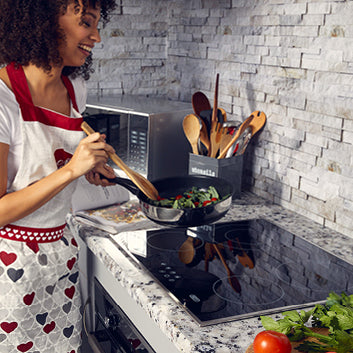With induction stove top cooking, your pan is heated by a magnetic field instead of having the bottom sitting on a flame like a gas cooktop or an electric top.
How do Induction Cooktops work?
Induction is an innovative method of cooking whereby the heating coils are powered by electromagnetic energy which directly heats the pots and pans.
There is no thermal heat which is why only the element in use will warm-up, with the heat directly transferred to the cookware through conduction and convection. This differs significantly from both gas and electric cooktops which transfer the heat from the burner to the pots and pans.
Is Induction cooking Better?
There are certainly many benefits associated with induction stoves, which is why many leading appliance brands are bringing them into the market.
Benefits of Induction Cooking
Here are some of the reasons why investing in an induction stove might be the best solution for your cooking needs.
Cooks food quicker
Induction cooking transfers heat directly to the cookware, bypassing the need for thermal heat which moves from the burner to the cookware. The food heats up significantly faster than on the traditional gas or electric stoves, sometimes up to 60 percent more.
Immediate temperature change
Induction cookers will respond almost immediately to temperature adjustments compared to electric stoves (similar to that of gas stoves) which makes cooking challenging recipes that much simpler.
Enhanced heat safety
One of the biggest hazards in the home is a heating device, such as a stove, but with an induction appliance, the risk is restricted. Because induction stoves heat the cookware directly, the stove surface will not get hot until the appropriate cookware is placed in the cooking zone. Likewise, the appliance will cool down much quicker than either gas or electric stovetops. Some of these appliances also come with smart sensors which will automatically switch off when not in use.
Enhanced flavors
Because the temperature adjustment is so precise, you’re able to cook any meal to perfection. The heat provided through induction is consistent, so there is minimal risk of under-or over-cooking any food item.
Easy to clean
Similar to the modern electric stovetops, induction burners are constructed from a smooth glass that is easy to clean. Because the burners don’t actually heat the cooktop, you don’t have the hassle of spills and mess burning the cooktop, which would make it harder to scrub.
Energy Efficient cooking
With induction cooking, the base of the cookware is heated by the magnetic field, so there’s no need to fit the pan or pot to the burner.
What to Consider When Buying an Induction Stove:
If you’re looking at investing in an induction stove, there are many factors that you’ll need to discuss with the supplier before settling on a model and make. Some of these include:
● Size: The induction stove will come with up to 5 induction zones, and the amount of simultaneous cooking you do will determine your cooking zone requirements.
● Standalone or built-in: If you’re designing a new kitchen then you’ll probably be considering a seamless, built-in model. However, if you’re considering a re-design in future or might move, then a portable option is best.
● Cooking zone: It’s best to go for an induction stove with an extra-large, flexible and small cooking zone to match all cookware requirements.
● Control panels: These come in rotating knobs, press button, or sensor controls and will range in price. Also ensure the control panels are not too close to the element.
Features to Ask About:
Different ranges of induction stoves will have different features that can enhance the cooking experience. When chatting to a supplier or manufacturer, these are some of the features you can discuss.
● Pre-set cooking: This is a user-friendly feature that will save you time, automatically adjusting the heat for grilling, stirring, boiling, and frying.
● Consumption display: An added energy-efficiency feature is the electrical consumption display which lets you know how much electricity you’re using at any time.
● Safety sensors: If the cookware is left unattended, the stove will adjust the heat to prevent damage to the cookware
● Smart applications: Modern induction stoves will be able to communicate with your smart devices for remote accessibility.
What’s the Verdict?
An induction stove might take a bit of getting used to but, when compared with gas and electric stoves, there are many advantages. The precise temperature control, fast heating and cooling, energy-efficiency, and safety features make this a top contender for the kitchen space.

